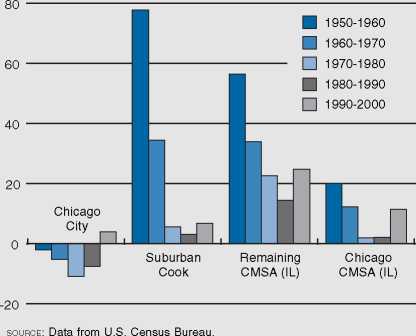provided by Research Papers in Economics
ESSAYS ON ISSUES
THE FEDERAL RESERVE BANK APRIL 2002
OF CHICAGO
NUMBER 176
Chicago Fed Letter
The changing face of Chicago: Demographic trends in the 1990s
by Kenneth M. Johnson, demographer and professor of sociology, Loyola University-Chicago1
The population of the Chicago metropolitan area grew by 869,000 (11.6%) between
1990 and 2000, the largest decade of growth in 30 years. The gain of 112,000 in the
City of Chicago was the first in more than 50 years. Overall, gains were greatest in the
outer suburbs and smallest in the city. Much of this growth was fueled by immigration
and natural increase, with Hispanics contributing disproportionately to both.
1. Population percent change, 1950-2000
percent change

According to recent U.S. census data,
the Chicago metropolitan area experi-
enced widespread population gains be-
tween 1990 and 2000. These population
gains are evident in the City of Chicago,
as well as in suburban Cook County
and the outer ring of the metropolitan
area. The overall popula-
tion gain in the metro area
was 11.6%, making this the
largest decade of growth in
30 years. The accelerated
rate of population increase
in Chicago mirrors that in
the East North Central
census region (Illinois,
Indiana, Ohio, Michigan,
and Wisconsin) and in the
U.S. Between 1990 and
2000, the East North Cen-
tral region grew 7.5% and
the U.S. grew 13.2%. Both
of these gains are the larg-
est since the 1970s. Relative
to other cities, Chicago’s
population gain in the
1990s ranked sixth overall
among the ten largest metropolitan
areas in the country.
This Chicago Fed Letter summarizes recent
demographic trends in the Illinois por-
tion of Chicago’s consolidated metropol-
itan statistical area,2 based on data from
the U.S. Census Bureau, the National
Center for Health Statistics, and the
Illinois Department of Public Health.3
These data reveal the complex interac-
tion of demographic forces that together
produced the area’s population gain.
Overview of population change
The population of the Chicago metro-
politan region grew by 869,000 (11.6%)
between 1990 and 2000. The region
had a total population of 8,376,601 in
April 2000, making it the third largest
metro region in the country. Gains
were greatest in the outer suburbs and
smallest in the city. The population in-
crease of 112,000 in the City of Chicago
was the first in more than 50 years
(figure 1). Suburban Cook County
gained 159,000 people during the pe-
riod and the outer suburbs gained ap-
proximately 598,000. Roughly 34.6%
of the area’s population reside in the
City of Chicago, 29.6% live in subur-
ban Cook County, and the remaining
35.8% reside in the outer suburbs.
Chicago’s share of regional popula-
tion has declined over the past several
decades, while suburban Cook County’s
and later the outer suburbs’ shares
have increased.
Hispanics fueled most of the growth
in the City of Chicago, whereas the
white and black populations declined.
The Hispanic population of the city
More intriguing information
1. AMINO ACIDS SEQUENCE ANALYSIS ON COLLAGEN2. The name is absent
3. Regional science policy and the growth of knowledge megacentres in bioscience clusters
4. The name is absent
5. CROSS-COMMODITY PERSPECTIVE ON CONTRACTING: EVIDENCE FROM MISSISSIPPI
6. Innovation Trajectories in Honduras’ Coffee Value Chain. Public and Private Influence on the Use of New Knowledge and Technology among Coffee Growers
7. The name is absent
8. DISCUSSION: ASSESSING STRUCTURAL CHANGE IN THE DEMAND FOR FOOD COMMODITIES
9. Imperfect competition and congestion in the City
10. The name is absent